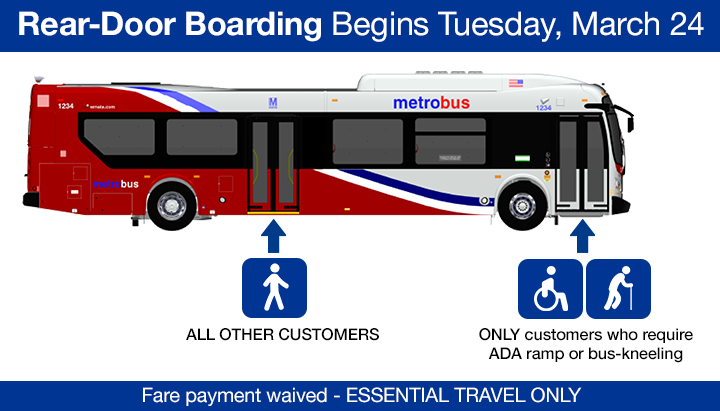Metrobus implements rear-door boarding systemwide, starting Tuesday
While emphasizing that bus service is limited to essential trips only, Metro is taking additional action to enhance the safety of its frontline workforce by implementing rear-door boarding across the Metrobus system, effective Tuesday, March 24. Several other U.S. transit systems have already implemented rear-door boarding in response to the COVID-19 public health emergency.
Starting tomorrow, all Metrobus riders are asked to enter and exit the bus using the rear door at all times, except anyone needing the ADA boarding ramp (e.g. people using wheelchairs), or anyone requesting the bus to “kneel” to facilitate their boarding.
Metro General Manager/CEO Paul J. Wiedefeld authorized rear-door boarding following a request from ATU Local 689 President Raymond Jackson, as an additional step to help protect bus operators working during the national emergency. Each of Metro’s 1,500 buses are already equipped with a plexiglass shield that provides a physical barrier between the operator and passengers, and Metro has given bus operators the discretion to bypass bus stops if they believe the bus is at its maximum capacity to maintain social distancing requirements.
Because farebox equipment is located at the front of the bus, Metro is waiving fare payment for Metrobus customers during this time.
Signage and plastic barriers have been installed to remind customers to use the rear doors, while not impeding customers’ use of the front door in the event of an emergency.
Metrobus ridership has declined 65 percent during the COVID-19 outbreak, a figure that is less than the 90 percent drop-off on Metrorail. The public is reminded that limited bus capacity must be preserved for essential trips – such as doctors, nurses, and first responders traveling to or from work. If you must travel, first consider other options, such as walking, biking, scooters, taxi, etc.
